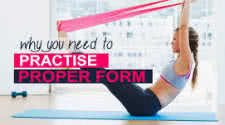The Key Importance of Proper Form during Exercise & Lifting

Advanced Overall Proper Fitness Studies & Exercise Research
Good form is essential to weightlifting. But, what is good form? If you're using weightlifting machines such as Nautilus, the proper form is usually clearly illustrated on a sticker posted on the machine, reports Kristl Bulurari in the Los Angeles Times.
If you're lifting free weights such as dumbbells and barbells with weight plates, keep the knees soft and slightly bent so that most of the pressure is borne by your thighs instead of the lower back, Remember this when you are between sets and changing the weight plates because,
even though you aren't doing a biceps curl, you are still lifting. Proper form also means helping your head and neck relaxed and keeping the shoulders down so you aren't hunching forward.
This prevents neck strain and the type of back pain you feel between your shoulder blades when you've spent the day hunched over your desk or at the computer. Also, keeping your hips and shoulders forward and square when doing squats, for example, will help prevent hip or back pain.
Another thing to remember to prevent strains is this: lift the right amount of weight-and no more. Lifting too much weight compromises proper form. Overlifting also tends to force you to rely on bodyparts other than the ones you are targeting.
For example, when doing biceps curls, a man who lifts too much weight will tend to arch his lower back because the biceps are not strong enough to lift the weight. The lower back compensates for this and moves back and forth as the arm lowers and lifts the weight. Done properly
and with the proper weight, however, the arm will be the only thing moving while the back, legs, and neck remain stationary.